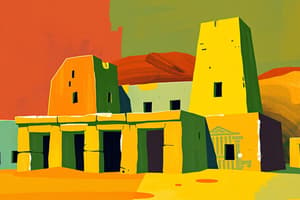Podcast
Questions and Answers
What general understanding about amounts did prehistoric ancestors possess?
What general understanding about amounts did prehistoric ancestors possess?
Prehistoric ancestors had a general sensibility about amounts and instinctively knew the difference between one and two.
What significant intellectual leap concerning numbers took ages to develop?
What significant intellectual leap concerning numbers took ages to develop?
The leap from the concrete idea of two things to the invention of a symbol or word for the abstract idea of 'two' took many ages to develop.
Why do some isolated hunter-gatherer tribes have limited number words?
Why do some isolated hunter-gatherer tribes have limited number words?
Some isolated hunter-gatherer tribes have words only for 'one', 'two', and 'many' due to the absence of settled agriculture and trade, which reduces the need for a formal number system.
What types of occurrences did early humans track, and how did this relate to their understanding of numbers?
What types of occurrences did early humans track, and how did this relate to their understanding of numbers?
What evidence exists that people were thinking about numbers around 35,000 to 20,000 years ago?
What evidence exists that people were thinking about numbers around 35,000 to 20,000 years ago?
How does the difference between counting and mathematics manifest in early human practices?
How does the difference between counting and mathematics manifest in early human practices?
What types of designs were represented by Pre-dynastic Egyptians and Sumerians as early as the 5th millennium BCE?
What types of designs were represented by Pre-dynastic Egyptians and Sumerians as early as the 5th millennium BCE?
What is the Ishango bone and its significance in the history of mathematics?
What is the Ishango bone and its significance in the history of mathematics?
How did bureaucratic needs influence the development of mathematics in ancient civilizations?
How did bureaucratic needs influence the development of mathematics in ancient civilizations?
What evidence exists for early arithmetic and geometric notations in ancient Ireland?
What evidence exists for early arithmetic and geometric notations in ancient Ireland?
Describe the significance of Stonehenge in relation to early mathematical practices.
Describe the significance of Stonehenge in relation to early mathematical practices.
What role did megalithic societies in northern Europe play in the early development of patterns and designs?
What role did megalithic societies in northern Europe play in the early development of patterns and designs?
How is the development of mathematics tied to the agricultural revolution in ancient civilizations?
How is the development of mathematics tied to the agricultural revolution in ancient civilizations?
What similarities exist between the numeric systems of ancient Sumerians and other early civilizations, such as those in Ireland?
What similarities exist between the numeric systems of ancient Sumerians and other early civilizations, such as those in Ireland?
Flashcards
Prehistoric number sense
Prehistoric number sense
Early humans instinctively understood differences in quantities like one and two.
Abstract vs. concrete numbers
Abstract vs. concrete numbers
Thinking of 'two' as a concept, not just two objects, was a huge intellectual leap.
Limited number systems
Limited number systems
Some tribes had only words for 'one', 'two', and 'many' due to a lack of complex needs.
Early counting methods
Early counting methods
Signup and view all the flashcards
Notched bones
Notched bones
Signup and view all the flashcards
Early counting vs. math
Early counting vs. math
Signup and view all the flashcards
Early geometric designs
Early geometric designs
Signup and view all the flashcards
Ishango bone
Ishango bone
Signup and view all the flashcards
Bureaucracy and math
Bureaucracy and math
Signup and view all the flashcards
Early arithmetic in Ireland
Early arithmetic in Ireland
Signup and view all the flashcards
Stonehenge and Measurement
Stonehenge and Measurement
Signup and view all the flashcards
Megalithic societies and patterns
Megalithic societies and patterns
Signup and view all the flashcards
Agriculture and math development
Agriculture and math development
Signup and view all the flashcards
Similarities in early number systems
Similarities in early number systems
Signup and view all the flashcards
Study Notes
Prehistoric Number Conceptualization
- Prehistoric ancestors had an intuitive understanding of quantities, recognizing the difference between one and two animals.
- Transitioning from concrete counting to abstract concepts represented by symbols took significant time.
- Some contemporary hunter-gatherer tribes in the Amazon only have terms for "one", "two", and "many", while others have words for numbers up to five.
Early Counting Evidence
- Lack of a formal numbering system due to absence of settled agriculture and trade.
- Early humans tracked occurrences like moon phases and seasonal changes.
- Notched bones from Africa, dating back 35,000 to 20,000 years, represent some of the earliest evidence of counting.
Ancient Societies and Mathematics
- Pre-dynastic Egyptians and Sumerians created geometric designs as early as the 5th millennium BCE, emphasizing artistic rather than mathematical practices.
- Megalithic societies in northern Europe also exhibited geometric designs around the 3rd millennium BCE.
- The Ishango bone from central Africa, approximately 20,000 years old, is an early counting tool.
Development of Mathematics
- Formal mathematics arose largely in response to bureaucratic needs of settled civilizations for land measurement and taxation.
- Mathematics first developed in Mesopotamian cities and ancient Egypt.
- Evidence of basic arithmetic and geometric notation on petroglyphs in Ireland from 3500 BCE to 3200 BCE illustrates early mathematical practices.
Cultural Mathematics and Stonehenge
- Knowth and Newgrange burial mounds feature zigzag glyphs used for counting, with this system continuing into the 1st millennium BCE in Britain and Ireland.
- Stonehenge, dating around 2300 BCE, displays use of 60 and 360 in its circular measurements, possibly unrelated to the Sumerian sexagesimal counting system.
Studying That Suits You
Use AI to generate personalized quizzes and flashcards to suit your learning preferences.




